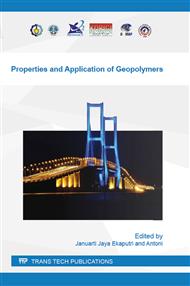p.48
p.55
p.59
p.65
p.72
p.79
p.83
p.90
p.98
The Use of Fermipan in the Production of Lightweight Geopolymer as an Environmentally Friendly and Fire-Resistant Concrete
Abstract:
This study aims at optimizing the utilization of fly ash (FA), rice husk ash (RHA), and fermipan for the production of lightweight environmentally friendly and fire-resistant geopolymer concrete. The geopolymer concretes were synthesized by alkaline activation method of FA added with RHA as light aggregate and fermipan as forming pores. The lowest density (1.55 g/cm3) of produced concrete was achieved with the addition of 26% of RHA and 6% of fermipan relative to the mass of FA. X-Ray Diffraction (XRD) indicates the formation of a new phase resulted from the reaction between fermipan and other oxides. The morphology of lightweight geopolymer was examined by Scanning Electron Microscopy (SEM). It was found that the matrix of the material consists of high volume of pores due to the inclusion of fermipan. The compressive strength of the lowest density sample was 16.56 MPa and fire resistance testing showed that this material was able to withstand temperature as a high as 1200°C.
Info:
Periodical:
Pages:
72-78
Citation:
Online since:
January 2016
Authors:
Keywords:
Price:
Сopyright:
© 2016 Trans Tech Publications Ltd. All Rights Reserved
Share:
Citation:


